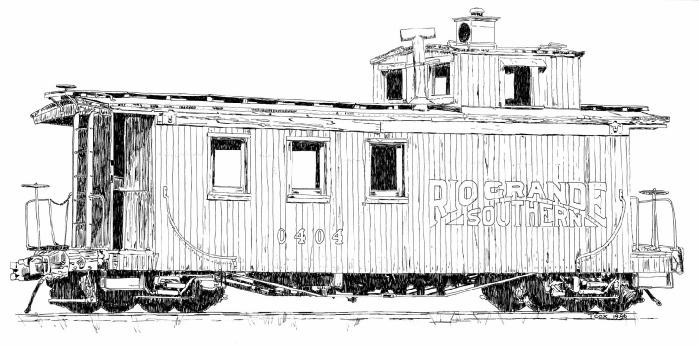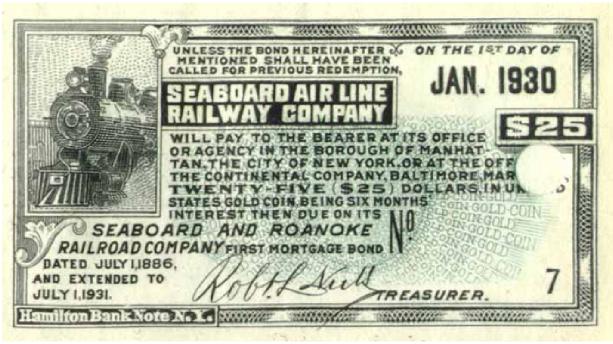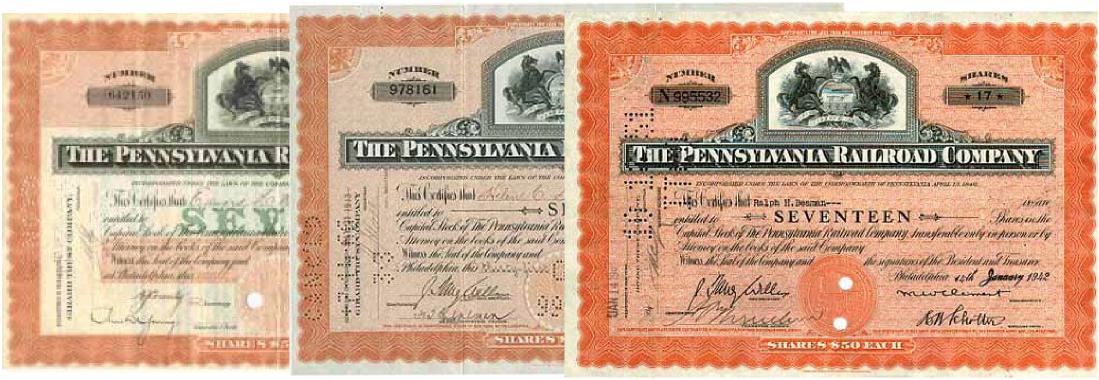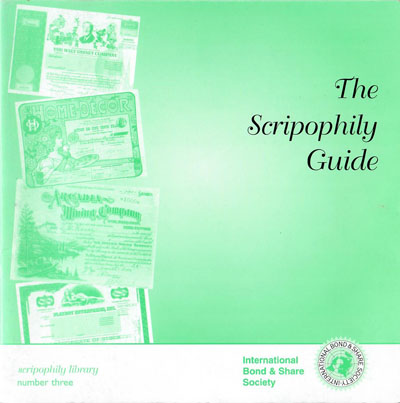
Discovering New Varieties
It is tremendous fun to discover something new. Back in the late 1960s and early 1970s, I was a caver. (Spelunker to people outside the sport.) Discovery was one of the main motivations for crawling through passages all over North America. That and adrenalin!
The stock and bond hobby is not particularly rich in adrenalin, but it certainly offers a lot of discovery!
I approach the stock and bond hobby
similarly. I love the discovery. But I cannot discover a thing without you!
As most of you know, I do not really collect certificates. I collect information. So, our partnership is completed when I compile the information and return it to you in a manner that will help you form better collections.
I have found, though, that many of you don’t realize how critical your involvement is to the hobby.
 Caboose from the Rio Grande Southern, one of the classic Colorado narrow gauge railroads. Fortunately for collectors, the company is represented by several varieties of certificates, including a few signed by narrow gauge pioneer, Otto Mears. Mears incorporated the southwestern Colorado road in November, 1889, but lost control after the 1893 Silver Crash wiped out profits. Control moved to the D&RGW, which moved freight over parts of the RGS until 1951. Track was removed in 1952. This line was probably most famous for the “Galloping Geese.” Drawing by Terry Cox
Caboose from the Rio Grande Southern, one of the classic Colorado narrow gauge railroads. Fortunately for collectors, the company is represented by several varieties of certificates, including a few signed by narrow gauge pioneer, Otto Mears. Mears incorporated the southwestern Colorado road in November, 1889, but lost control after the 1893 Silver Crash wiped out profits. Control moved to the D&RGW, which moved freight over parts of the RGS until 1951. Track was removed in 1952. This line was probably most famous for the “Galloping Geese.” Drawing by Terry Cox
First, realize that discoveries can be any size. You get to decide what constitutes a discovery. Things that are important to you will be different for other collectors. And what is important to you will be exactly what you will find.
Second, realize that discoveries can seem very minor at the time and yet affect later, more important, discoveries. No discovery ever exists in a vacuum. Every discovery and invention is built on the foundation of previous work.
Third, realize that I will not bite. I do not consider myself an expert. I see myself as simply an information geek. I am in this hobby strictly to have fun and share the fun with you. I believe that all of our fun is simply foundational work for the collectors and experts who will come after us.
So what areas are ripe for discovery?
New company names — Check my online database. It contains the names of all railroad-related companies I know of. If that interests you, I guarantee you can help. One collector of eastern Pennsylvania railroads added 100(!) new names last month alone.
Add details to company names — Any company listed in the database without the word railway or railroad in the title probably needs completion.
Dates of company re-incorporations — You can help discover the dates of multiple incorporations. This is a huge, untapped area especially designed for people who have access to old Moody’s or Poor’s Manuals. Companies represented by multiple first mortgage bonds are excellent places to look for new incorporations. Or you might help solve some of the “questionable” companies listed on my web site. Those are companies that are represented by certificates, but I have never confirmed railroad relationships.
Certificate varieties — Many collectors want to discover new varieties of certificates. And there are lots of varieties left to find based on differences in vignettes, colors, revenue imprints, interest rates, and bond series. There are hundreds of varieties left to discover among equipment trusts.
Certificate sub-varieties — For the “hair-splitter” personality, I will tell you right now that you will have a field day. There are tons of sub-varieties left to discover! While the definition of sub-variety might be a little vacuous, a sub-variety can entail minor differences such as the printed portions of dates, printers’ names, capitalization amounts, CUSIP numbers, and par values. If you have a certificates that don’t match my descriptions thoroughly, you might have sub-varieties to contribute.

A recent sub-variety discovery appeared among the super-common West Shore Railroad Co. bonds. That company’s registered bonds spanned the century boundary, and therefore created sub-varieties with printed dates of ‘18—’ and ‘19—.’ Yet those sub-varieties had escaped detection for years. Similar finds are certainly awaiting among other registered bonds.
Serial numbers — I am now listing serial numbers on my web site and they are beginning to reveal new, hidden, sub-varieties. Here, the trick is to look closely at certificates with serial numbers significantly outside the recorded ranges. Prefix letters are often very helpful in this regard.
Celebrity signatures — In general, I try to avoid listing the autographs of minor or regional personalities. The reason I do not include such autographs is because values can vary dramatically from sale to sale, and year to year. I want to avoid giving the impression that minor celebrity autographs are going to be valuable over the long haul. On the other hand, there are many signatures of famous people waiting to be included. If you have a certificate/autograph combination that I don’t have listed, then you have a discovery to contribute.
Corrections — The database and web site now holds over a million words! If you can’t discover a mistake I’ve made, you’re not trying.
568 New Certificates Since March
|
1st Edition |
Last Issue |
Currently |
| Number of certificates listed (counting all variants of issued, specimens, etc.) |
8,559 |
14,112 |
16,803 |
| Number of distinct certificates known |
7,152 |
11,146 |
13,020 |
| Number of certificates with celebrity autographs |
699 |
1,175 |
1,335 |
| Number of celebrity autographs known |
232 |
342 |
317 |
| Number of railroads and railroad-related companies known |
17,276 |
19,805 |
23,221 |
| Number of companies for which at least one certificate is known |
3,516 |
5,001 |
5,662 |
Example of how sub-varieties are discovered
The theme of this issue is discovering new varieties, so let me give an example of how it works.
Just one week before writing this issue, one of my major European contributors asked me about a stock certificate from the Pennsylvania Railroad. It was one of the most common varieties with the state seal. He said his had a ‘190—’ printed, while the database referred to a ‘19—’ printed date.
His simple question forced a re-examination of references and photos and resulted in discovering a fourth sub-variety. Theoretically, dealers must have noticed them before, and just never recorded their observations in print. Are there more still sub-varieties to be found?
This points out that discoveries can be made among the most common certificates. A virtually everyone has the possibility of contribution. What is important to me is that we work together to pass our findings on to the collectors who will come after us.
I wish I had the second edition in book form so everyone could compare their certificates with those already recorded. The second edition of the book is still on hold, so the only thing I can do right now is give you access to the database across the internet. Unfortunately, that leaves out many collectors who are not yet connected to the web. Or who do not speak fluent English.
In the interim, you may continue to use the first edition of the catalog and make comments on possible varieties you discover. Please, do not think your contribution must be major to be useful. Even your contribution of serial numbers is quite valuable.
 Example of PEN-317-S-50 on the left. It is handsigned and shows a partial orange underprint in the top third of the certificate. In the center is S-50a, also handsigned, but with a full orange underprint. At right is S-50b, with a full underprint, but with facsimile signatures. All shares have a $50 par value. S-50c (not shown) has an overprint which changed the par value to $10.
Example of PEN-317-S-50 on the left. It is handsigned and shows a partial orange underprint in the top third of the certificate. In the center is S-50a, also handsigned, but with a full orange underprint. At right is S-50b, with a full underprint, but with facsimile signatures. All shares have a $50 par value. S-50c (not shown) has an overprint which changed the par value to $10.
PEN-317, Pennsylania Railroad Co.
Example of currently known varieties of stock certificates with state seal (two black horses) above flat title
|
<100 shares
orange |
100 shares
green |
500
shares
maroon/red |
1,000 shares
purple |
5,000 shares
olive |
| $50 par |
|
handsigned, partial color underprint
|
S-50 |
S-51 |
S-52 |
S-53 |
S-54 |
|
handsigned, full color underprint
|
S-50a |
S-51a |
|
S-53a |
|
|
facsimile signatures, full color underprint
|
S-50b |
S-51b |
S-52b |
S-53b |
S-54b |
| $10 par overprint |
|
facsimile signatures, full color underprint
|
S-50c |
S-51c |
|
S-53c |
|
Opportunities for rarities
I have a few correspondents who routinely surf internet auction sites in search of new certificates. The number they find is intriguing. (Because of the constant flood of submittals, I do not have the time to check sites on my own.)
Most intriguing to me are the low prices they report and the possibilities internet auctions represent to other collectors.
I do not have the data for a statistical study, but a number of relationships SEEM to exist.
It seems to me that experienced dealers are snapping up some great certificates at great prices. However, because of the necessity of leaving room for profits, dealers can never bid as much as collectors. Collectors always have the edge in bidding. On the other hand, dealers usually have the edge in knowledge.
It also seems that when selling via the internet, experienced sellers and professionals attract higher bids than amateurs. Experienced sellers know the tricks of presentation and descriptions. Moreover, they often have lists of collectors they contact to let them know of upcoming sales.
Most importantly for you, it seems that good presentation is crucial. No matter how rare certificates may be, auctions illustrated by bad and low quality images almost never attract decent bids. The opportunity for you, as a collector, is to bid on certificates with bad photos. It appears to me that bad photos equal low prices.
Now, by no means am I saying to form a collection solely from internet sales. As most of you know, I emphatically recommend a very focused, specialized approach. And I heartily recommend forming good relationships with several dealers, across the entire price spectrum. Good relationships make for good collections. Let them know your specialty and dealers will work to build your collection.
But I am also saying that if you ignore internet auctions, you will ignore some sensational rarities. I am specifically suggesting to use all the resources available to you.
New IBSS booklet

The International Bond & Share Society recently published The Scripophily Guide, a well-written 32-page introduction to the hobby. This is a no-fluff publication packed with serious, hard-won advice and observations. I recommend it to everyone even moderately interested in collecting stocks and bonds.
You may buy The Scripophily Guide from major dealers including Scott Winslow, George LaBarre, and R.M. Smythe. Wherever you get it, please do so.
But, more importantly, I want you to join the IBSS. Please, don’t bother arguing about not being advanced enough! I don’t want to hear it. This is THE organization dedicated solely and exclusively to the stock and bond hobby, from beginners to experts. If you
are going to collect stocks and bonds, then get serious and
join the IBSS!
International Bond & Share Society
www.scripophily.org